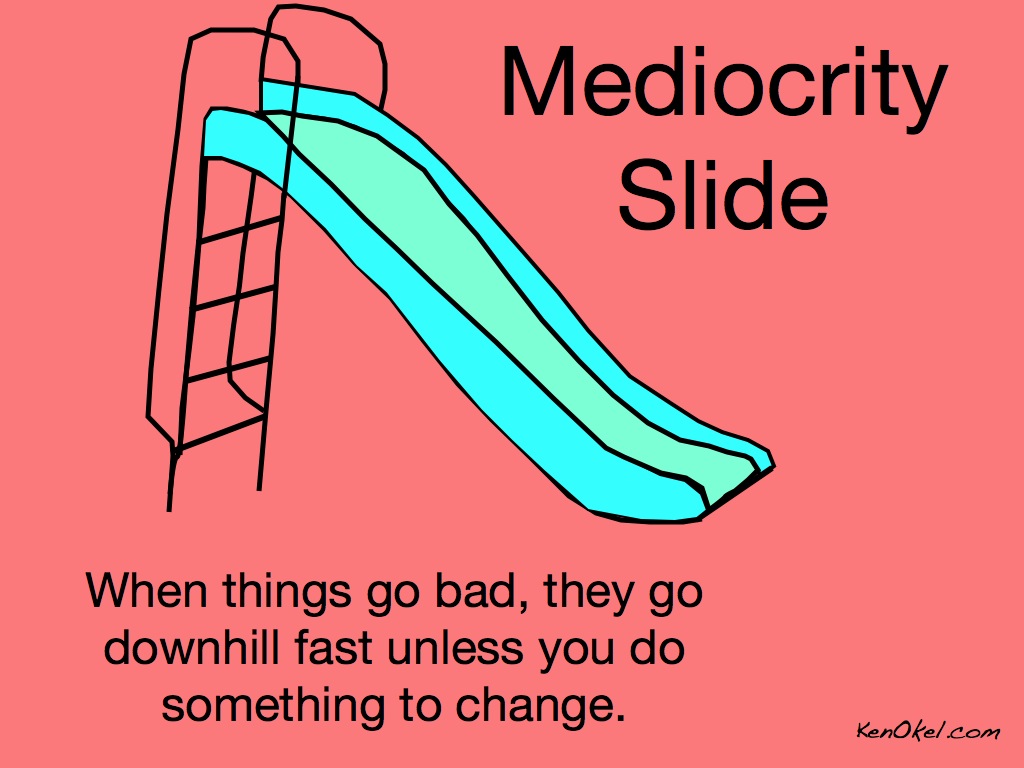 Great organizations do not change for the worse overnight. It’s something that happens in stages. For an organization going down the mediocrity slide, it will take a very long time to get back to where it was.
Great organizations do not change for the worse overnight. It’s something that happens in stages. For an organization going down the mediocrity slide, it will take a very long time to get back to where it was.
As you might guess, great experiences keep people coming back. Poor experiences push customers elsewhere. Then it’s much harder to woo them back.
How do you Clear the Path of the challenges that open the door to mediocrity? Here are some suggestions to keep you either moving up or staying at the top of your game:
Keep Learning: A funny thing can happen when people stop learning. They start to look for shortcuts. These aren’t things that boost productivity or streamline processes. Instead, these are things that make the employee’s life easier at the expense of the organization.
This cutting of corners can become contagious. People start to say, “Why do I have to follow the rules if no one else does?”
To prevent this from happening, you need to maintain continuous training. Don’t assume that people, who know the policies, will continue to follow them. Your customers will notice when they don’t.
Some supermarkets use software that monitors the speed at which their cashiers ring up purchases. Employees like this in that it gives them constant feedback. Slow employees can be coached to improve their output and high performers can have evidence of their skill.
Why make the investment? Checkout time can be a determining factor in bringing back a customer. What keeps your customers coming back?
Misunderstanding Success: There’s an old joke about the journeyman basketball player who gets a couple of minutes on the court, playing alongside a superstar like Michael Jordan or Lebron James. The superstar scores 48 points. The reserve player scores a basket in the final seconds of the game. From that moment on, he talks about the night when he and the superstar teamed up to score 50 points.
While the statement is true, it’s not really accurate in that it overstates the journeyman’s contribution to the game. The same thing can happen in an organization where sales people rely too much on top performers. It’s easy to coast if you know that another member of your team will bring up the average. That is, until the superstar has a bad week, month, or quarter. Then it becomes apparent that not everyone is performing to their full ability.
Evaluate individual performance and not just the work of the group. It’s a good reminder that improvement and high performance are expected.
Do You Have a Team or Individuals? Have you ever been in a busy office and seen a piece of paper on the floor? It’s obviously trash but no one is picking it up and putting it in the garbage can. This drives me crazy.
It’s as if people say, “My job description doesn’t say that I should pick up trash, so I’ll leave it for the janitor to get hours later.” Meanwhile you have trash on the floor.
Perhaps this narrow vision is a product of the recession, where employees found themselves being asked to do more and more work for the same compensation. But it’s created silos where people let their anger at a company poison the customer experience.
Remind your team that for the organization to succeed and grow, they must think of themselves as important parts of a whole. In many cases, the extra work that is performed, like picking up a piece of trash, will go unnoticed. But leaving trash on the floor will create an impression on customers.
When performed well, there are no small jobs. All make up a well oiled machine. Make sure everyone takes responsibility and pride in their role.
Final Thought: Most organizations are either going up or down. They rarely stay the same. As a leader you can make a daily commitment to the direction of your company.





